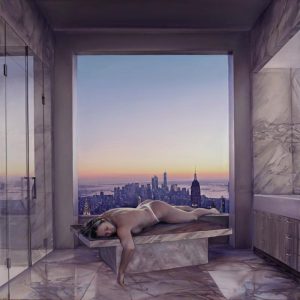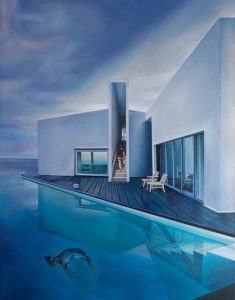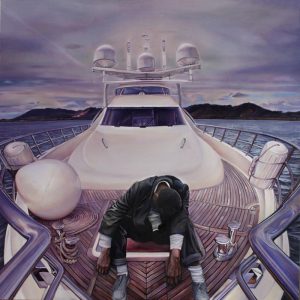The work of artist Lily Morris has a surreal quality. Even though the figures and the landscapes that present themselves are painted in a highly realistic style, and the world portrayed is not outside the realm of possibility, there’s a dreamlike, even unsettling quality to the work, almost as if Ms. Morris had captured a snapshot of a scene from the subconscious.
In many cases, especially in her most recent series, “American Dream,” two worlds collide. The natural world and the artificial share an uneasy relationship. For example, in “Lost,” a fawn is pictured having emerged from a lush, wooded background to drink from a sterile manmade pool. In “Country Home,” Ms. Morris portrays an ultramodern luxury home that manages to shut out every bit of its natural surroundings. A huge swimming pool even mimics and replaces the ocean that juts right up against the house. The only sign of nature is a dead deer floating in the pool.
The work is fascinating — both familiar and unreal at the same time, and there’s a cinematic feel to the paintings.

Perhaps the young artist’s various life experiences have informed her work. From the idyllic surrounding of her Martha’s Vineyard home, where she spent her childhood, Ms. Morris then set out on what sounds like an epic odyssey exploring the world and, in particular, urban areas.
“I definitely felt that I had to fling myself into the world to learn what I needed to learn and investigate all angles of the human experience,” says Ms. Morris. “It would have been too much of a spectacle to evolve from a child to an actualized human being here. I needed to be far, far away from the loving and watchful eye of our community.”
Far away — in both a literal and a figurative sense — is where the artist’s journeys took her.
After earning a bachelor’s degree from the Massachusetts College of Art and Design, she settled for a while in Philadelphia, where she shared a huge warehouse space with a group of artists who slept all day and worked all night on robotic art. Then Ms. Morris spent a few months in an artist’s residency in Beijing, before moving to Brooklyn. (She has also done residencies in Austerlitz, N.Y., and Florence, Italy.) However, she found life in the city too distracting to allow her to focus on her work. Eventually she settled in rural Hudson, N.Y., two and a half hours from New York City.
The dichotomy of her experiences is reflected in the latest series of work. “‘Country Home’ is about having so much control in your life that you build out the opportunities for chaos — chaos being nature,” says Ms. Morris. “It came from this feeling that I had living in the city, ordering food online on my phone and not interacting with anyone. I had total and utter control of my life, and because of that I was isolated. That’s the general idea of the series.”

Other images focus on isolation and disillusionment. In one, titled “Yachting,” a man is seen sitting despondently, head down, at the prow of his luxury boat. In “Park Ave.,” a nearly naked woman lies corpse-like on a marble table in an apartment whose window looks out onto a spectacular view of the NYC skyline.
“That apartment on Park Avenue is in the tallest, most expensive residential building in New York City,” says Ms. Morris. “In many ways it represents the zenith of the New York luxury dream, but again, wealth and control and exclusivity can often come with a kind of emotional poverty. You don’t realize when you have all the control in the world, you experience exactly what you want. You only deal with who and what you want to see. You don’t butt into anything you don’t want to deal with.You’re almost deprived of experience.”
In Ms. Morris’ artist statement, she describes her latest series: “In my current body of work, I attempt to paint a more flawed and vulnerable experience into these projections of the American dream, shifting the focus from symbols of wealth and prestige to more human questions about balance, control, and fulfillment. I’m particularly interested in the relationship of exclusivity to isolation, celebrity to predation, and wealth to fear.”
The Celebrity paintings make up another part of the American Dream series. In this group of three paintings, Ms. Morris depicts beautiful women assaulted in one way or another by obsessed fans — either in the form of actual people, a blinding light or, in one case, a pack of carnivorous animals.
“‘Celebrity 1, 2, and 3’ are about the fragility that is innate in this idea of celebrity,” says Ms. Morris. “The people who make you powerful start to control your identity. They can make or break you. Their relentless curiosity means that you can’t regenerate. You become this thing to be consumed. You’re being almost preyed upon. It goes from being super-empowering to predatory.”

Ms. Morris sees the idea of celebrity and fabricated personality extending to everyday people through the Internet. “I started getting deeper into the Internet as a hive mind,” she says. “A singular mind of our culture. This idea of the modern self is really the leading concept of the Internet. It’s a vehicle to be any version of yourself that you want. You can create celebrity and recognition with total control over your identity.
“It’s really interesting how the modern identity has merged with marketing tactics. People brand themselves in the way companies used to brand themselves. People are producing commercials of the people they would like to be. I find it very interesting that we have the tools and desires to do that.”
Ms. Morris also mines the Internet for inspiration, gathering images that capture her attention. “The internet is an ideal place to collect people,” she says. “I fish from all corners of the Internet. I have this catalog of images. I use these elements like words in a poem.”
Prior to working on her most recent series, Ms. Morris completed a commission involving depictions of each of the “Seven Deadly Sins.” As one might imagine, the series is very dark in nature, almost grotesque in some cases. Working on that series led the artist to focus on some of the more negative aspects of the human condition.
“I submerged myself in some of the lowest vibrational content that exists in the world to do research and development for that,” she says. “Horror and darkness are a form of high energy. It’s Interesting that I can become immersed in that. It’s not something I naturally would gravitate toward.”
However, that theme did in some ways give rise to the latest series. The frailty of human nature, combined with the political climate at the time she was working on the series (during the election season) gave Ms. Morris a certain perspective that she has tried to capture in her “American Dream” paintings.
“I was thinking about the values we have as a country,” she says. “I guess I was trying to understand a more human side to reaching for this ephemeral American dream. What is the American dream these days? What would it actually look like to reach these cultural goals? I think the clumsiness of being a human would make any lifestyle look a little different than one might imagine.”
A Gallery, 8 Uncas Ave., Oak Bluffs, hosts an opening reception of Ms. Morris’ work on Saturday, July 1, 5 to 7 pm. The exhibit will be up at A Gallery through July 18.
